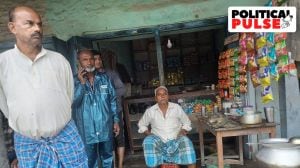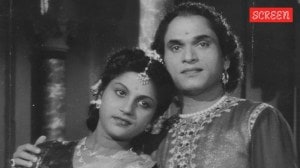The story of salvation
There Saadat Hasan Manto lies buried -- and buried in his breast are all the secrets of the art of story writing. Even now, lying under...

“There Saadat Hasan Manto lies buried — and buried in his breast are all the secrets of the art of story writing. Even now, lying under tons of earth he is wondering whether he or God is the greatest short story writer”. This is how Manto (1912-55), the enfant terrible of Urdu literature, wrote his own epitaph a year before his death.
Ismat Chughtai, one of Manto’s contemporaries and a literary genius in many ways, enriched Urdu literature with her unique style, sensitivity and humour. Drawing themes of her best stories from the lives of the Urdu-speaking women which she depicted vividly, ruthlessly, and at the same time with the deepest sympathy, she wrote with an authenticity which no male writer could have matched. She did so in the India of the 1930s and 40s. As the translators of her short stories point out, she “led her female contemporaries on a remarkable journey of self-awareness and undaunted creative expression”.
Recently, the English department at the University of Delhi has done a gooddeed by introducing these two outstanding fiction writers in its curriculum. Well done! I hope others would consider doing the same. Yes, teachers and students must be acquainted with our own rich and vibrant literary past.
At the same time, they must be told time and time again that writers like Ismat and Manto were not different or unique’ just because they used Urdu, the language of the Other, to express their creative energies. Like many of their contemporaries writing in Hindi or Bengali, they illuminate aspects of our collective existence that are often left untouched by political and economic practices.
They offer multiple versions of truth’ and thus contribute to a richer understanding of social and historical contexts. A more basic point needs reiteration. Generally speaking, Indian literature has played a crucial role in shaping the cultural and political struggles and contemporary consciousness. Moreover, it has long played a crucial part in giving marginalised groups a voice in the greatferment and tumult of the subcontinent. Some of the most interesting new writing has emerged in the context of the radical protest movements of the disadvantaged groups, such as the dalits and women. Unsurprisingly, the Indian storytelling has proved to be an instrument of resistance to tyranny, as well as a site of reconciliation and reversal of the orthodoxies of hatred that pervade the subcontinent’s politics.
Munshi Premchand, the master storyteller, explained: “The literateur… shows us the path, he arouses our humanness, infuses in us noble feelings, broadens our view…” He believed in the social function of art. The writer, for him, was a missionary who had to gear his writing to the deliberate portrayal of reality — in particular its decadent features, with the intention of reforming it. “Our social and political circumstances”, he wrote to a friend, “force us to educate the people whenever we get the chance. The more intensely we feel, the more didactic we become”.
Of all the forms ofliterature in modern times, fiction is a privileged site because in fiction, perhaps better than anywhere else, one can see the working of ideology in the lived experience of society. I refer to short stories because of its pivotal position among various forms of literature, holding as it were “eternity in a grain of sand”. In the words of Amitav Ghosh, “nothing that India has given the world outside is more important than its stories. Indeed, so pervasive is the influence of the Indian story that one particular collection, The Panchatantra (The Five Chapters) is reckoned by some to be second only to the Bible in the extent of its global diffusion”. The short story, both in its epic form and in its modern version, has been vital to the creation of the traditions of narrative and the diffusion of a civilisation, “the chosen instrument of the subcontinent in the springtime of nationhood”.
Scores of writers, Manto and Ismat included, capture the trauma of Partition in August 1947, the woes ofdivided families, the agony and trauma of abducted women, the plight of migrants and the harrowing experiences of countless people who boarded the train that took them to the realisation of their dream, but of whom not a man, woman or child survived the journey.
These experiences are portrayed through characters like Zahid in Attia Hosain’s Sunlight on a Broken Column or a Saddan in Masoom Reza Rahi’s Aadha Gaon (Half-a-Village).
Literature truly evokes the sufferings of the innocent, whose pain is more universal and, ultimately, a vehicle of more honest reconciliation than political discourse.
Board Krishan Chander’s Peshawar Express or Khushwant Singh’s Train to Pakistan to grasp the implications of what happened before and after the midnight hour. Turn to Rahi’s Gangauli village to uncover how the intricate and almost imperceptible way in which the politics of partition worked its way into the people’s consciousness. Read Attia Hosain’s Sunlight on a Broken Columnto discover how the Pakistan movement split families on ideological lines and heightened their anxieties.
Manto, for one, was accused of cynicism and sensationalising a tragedy. A critic even went so far as to say that Manto had desecrated the dead and robbed them of their possession to build a collection. This was unfair criticism. The fact is that, to a historian like me, Manto and many other creative writers expose the inadequacy of numerous narratives on Independence and Partition, compel us to adopt new approaches that have eluded the grasp of social scientists, and provide a foundation for developing an alternative discourse to current expositions of a general theory on inter-community relations.
They portray a grim and sordid contemporary reality without drawing religion or a particular community as the principal reference point. In the words of Krishna Sobti, whose best-known Hindi writings on Partition are Sikka Badal Gaya and Zindaginama, the fiction written about Partitionpreserved the “essential human values”.
We, on the threshold of the next millennium, are in a different position than the men and women of August 1947. Our choices are not limited to exile, death or resignation.



- 01
- 02
- 03
- 04
- 05




























